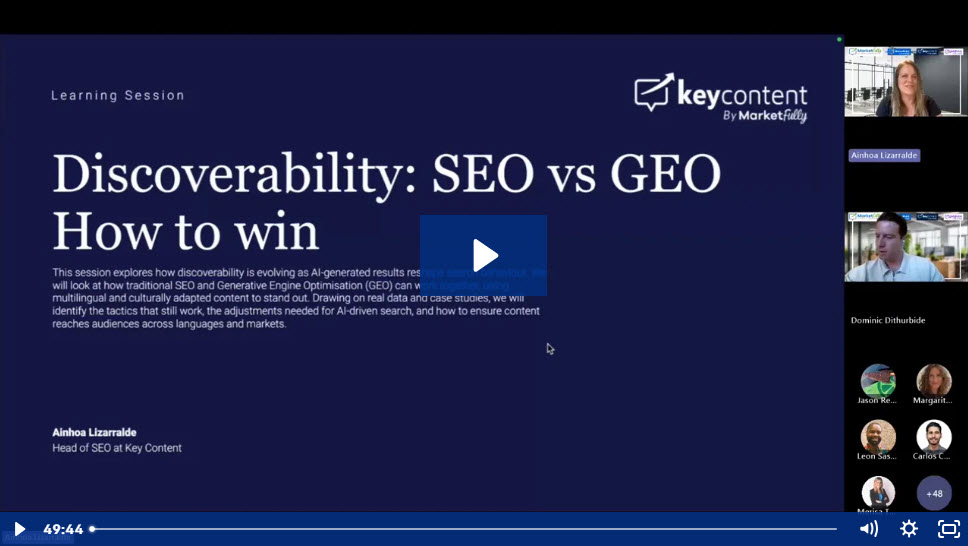Intertwining culture into multilingual content
Your brand’s voice is a cultural ambassador, and you must use it in the right way with language, tone, and context. Cultural intelligence is the ability to understand and navigate different cultural norms, and it is the compass that guides content creators across various languages and borders.
Weaving cultural intelligence into your content means adapting messages to local values, beliefs and customs, which is especially critical for sensitive topics like healthcare advice, mental wellbeing, gender, race, religion, and the like, where assumptions or taboos vary by culture.
Cultural sensitivity in these areas can make or break trust: a brand that misspeaks about health or faith can alienate its audience, whereas one that shows understanding can build bridges.
Think of cultural intelligence as a tuning fork. Just like a tuning fork resonates at the correct frequency, culturally intelligent content is created to resonate with its audience’s expectations. You’ll need deep local insight, from idioms and customs to privacy norms and power dynamics. As one might put it, cultural sensitivity is the awareness and appreciation of the values, norms, and beliefs that are characteristic of a cultural, ethnic, or other group, accompanied by a willingness to adapt your behaviour accordingly.
When it comes to content creation, you have to go beyond modifying just the language. You need to modify your entire messaging strategy. As an example, healthcare content in the U.S might focus on patient autonomy, while in another culture it might emphasise family involvement, which is a nuance that goes far beyond literal translation.

Why sensitive topics need more than translation
The short answer is that a direct translation often ignores context. A medical brochure translated word-for-word might sound sterile or even offensive if cultural norms differ enough. Cultural sensitivity has a profound impact in healthcare by helping to overcome health disparities, improve care quality, and meet legal mandates.
Globally, patients bring their beliefs about illness and treatment into every interaction, and mental health content is fraught with cultural taboos and stigma that direct translation can mishandle. E.g., Messages about depression or therapy must be reframed in culturally acceptable terms, in case they’re ignored or misinterpreted. Similarly, content on gender, race or religion also requires extra care. A term that’s neutral in one culture may be derogatory in another, or advice that’s empowering in one society might be taboo in another. Ignoring these nuances can alienate readers rather than engage them.
The main difference between translation and multilingual marketing is that translation converts words, while multilingual marketing adapts strategy.
Global SEO specialists note that “multilingual content marketing creates and distributes native-language content that matches local search behaviour, cultural context, and buyer intent,” building trust far faster than direct translation alone.
So, effective localisation creates and moulds your content around the specific audience by rewriting keywords and metadata for local search engines, swapping imagery for culturally familiar scenes, adjusting tone, and even rethinking humour and metaphors. A playful campaign slogan about “breaking the ice” might need a completely different image if ice-breaking is not a common phrase in the target language. Companies that focus only on word-for-word translation risk stumbling into cultural missteps. Ignoring local taboos and sensitivities can alienate your audience and lead to backlash.
Instead, successful brands localise to humanise, which is a term you’ll likely be seeing a lot of. They research how people search, speak, and live in each market, and tailor content accordingly. This might mean changing product names (like when Chevrolet’s “Nova” famously failed in Spanish-speaking countries), using local units of measure and currency, or adapting visuals (like using more modest imagery in more conservative locales).
Tuning personas and brand voice to local ears
Every market has a distinct personality, and it’s your marketing strategy’s job to identify that personality and tailor content to it. Building a semi-fictional profile of a target customer, called a localised buyer persona, is how you start composing the right notes for the right audience. You’ll need to start with demographics (age, gender, job, location) and layer in psychographics (values, motivations, goals).
In multilingual marketing, ask yourself a couple of questions to help you add cultural attributes, including “What languages do they speak?”, “How do local customs influence their decisions?”, “What’s the local nomenclature?”, etc.
E.g., High-context cultures (like Japan) rely on implicit communication, while low-context cultures (like Germany) value directness more. When you understand these traits, you can shape and format your content better.
Once you have the persona, you must adapt your brand voice to fit that local identity. A witty, informal U.S. voice might read as flippant in a culture that expects seriousness. On the other hand, a respectable global copy may fail to excite younger audiences abroad. A brand voice can stay consistent in values, but it has to flex in style.
For example, Netflix localises humour and dialogue in subtitled content so each culture laughs or cries in the right way. Amazon and IKEA hire local writers to make sure catalogues feel native. IKEA’s India catalogue, for example, swapped Scandinavian minimalism for vibrant colours and tight designs suited to Indian urban homes.
In Catalonia, using Catalan alongside Spanish in marketing can show respect and build trust with local audiences. Even simple tone shifts, like more formal greetings and different idioms can make content resonate better. Research shows that 86% of buyers prefer marketing that’s in line with their goals and understanding.
To develop these personas, you have to mix data with empathy and local understanding. Survey local customers, interview native sales reps, and consult local influencers to get the kind of information you need. You must capture unique behaviours, like “do customers in Indonesia rely on mobile-first shopping?”, or “are long-form articles read in Brazil, or better replaced by video?” and then pull those insights into everything from blog topics to social posts.
Make sure to keep your personas dynamic over time by updating them annually or after big events. A collaborative feedback loop, where marketing listens to sales, customer service, and local teams, is a great way to keep your personas relevant.

Creating content with cultural care
Even the best planning can fall short without the right checks in place. A strong workflow must integrate cultural reviews at every stage. First, involve cultural consultants or in-market experts to advise on everything from colours to historical context. Translated drafts should then be reviewed for language and nuance.
Training is also key. Giving translators and editors cultural training on things like “collectivism vs. individualism” or “high-context vs. low-context communication” will make them more keenly aware of cultural nuances and sensitivities. They need to understand local honorifics, humour norms, and even body language cues, so their word choices feel natural.
Cultures evolve, and so should content teams. Sending writers to local events or pairing them with in-market colleagues keeps insight fresh. Learning should be a constant.
Next, you’ll need to establish a cross-functional review process. Have content creators, translators, SEO specialists, and legal advisors collaborate. Have regular meetings to highlight potential issues early on, encourage open and transparent communication between translators, localisers, and content creators, and create cross-functional teams with cultural consultants and subject experts.
This might mean giving draft content to a regional editor, compliance-checking by a legal team, and using an analyst to confirm keywords. Build this into your project plan so nothing goes live without at least two native speakers green-lighting it.
Another best practice is iterative user testing. After translation and localisation, do field tests or focus groups with actual target users and gather feedback on wording, imagery, and tone. E.g., Did the Portuguese campaign resonate, or did locals find it off-putting?
Finally, make sure you are legally and culturally compliant. Different countries have different rules on things like advertising healthcare claims, mentioning protected groups, or data privacy. The localisation team needs to review the content for these regulations.

International SEO speaks Google’s language, too
A culturally intelligent site needs to be human-friendly, but also search engine-friendly in every market. International SEO tactics make sure your localised content is found by the right audience. At the technical level, this starts with geotargeting. Use country-specific domains (e.g. .fr, .de) or well-structured subfolders (/fr/, /de/) to signal each market.
Search Engine Land notes that country-code top-level domains (ccTLDs) send “the strongest geotargeting signal” to search engines.
When budgets or branding stop you from having separate domains, implement hreflang tags. The HTML annotations will tell Google “this page is the English (UK) version” vs. “this one is English (US)”.
Without hreflang, Google may serve the wrong page or even treat alternate versions as duplicate content, which is a risky slip in any campaign. Always include a fallback (x-default) tag too, so users with unmatched locales aren’t left swimming in the void.
Localise your keywords and metadata. Research what locals are actually searching, rather than simply translating your metatitle. SEO localisation means finding keywords that people are searching for in each market, not forcing a one-to-one translation.
Another example, the English phrase “sustainable fashion” became “mode éthique” (ethical fashion) in French, boosting search volume from 320 to ~1000 per month. Update title tags and meta descriptions with these high-impact local terms.
Localisation in action
History is full of lessons on multilingual content, and when used correctly, the wins can be huge. Netflix is famous for going beyond subtitles, like with its investment in Korean drama (e.g. Squid Game) that didn’t just entertain, it added $1 billion to the company’s value. By hiring local writers and respecting Korean storytelling traditions, Netflix tapped deep cultural enthusiasm and then sold that appeal globally.
Similarly, IKEA didn’t just ship its Swedish catalogue to India, it hired Indian designers and photographers to reflect the local homes. They adjusted colour palettes, furniture dimensions, and even catalogue narrative styles to fit Indian urban lifestyles. These localised catalogues helped IKEA capture one of the world’s fastest-growing markets.
Another inspirational example is Duolingo’s “Love Language” campaign. To promote language learning, Duolingo created a playful international ad series mimicking a dating show with multilingual contestants. The key was localisation. Humorous subtitles were tailored to each language’s quirks, so viewers from Spain to Brazil found it equally as charming. The result was a viral hit with 70 million social impressions and 1.1 billion total impressions.
A checklist of best practices for cultural intelligence
To navigate the complexity of sensitive multilingual content, follow a checklist of best practices:
- Embed cultural intelligence from the start. Train your team on cultural awareness by hiring or consulting local experts. Understand idioms, etiquette, taboos, and values in each target market.
- Develop detailed buyer personas for each location. Research demographics and cultural psychographics and use local surveys or focus groups to purify personas and avoid overgeneralising a region.
- Adapt messaging rather than just words. Adjust the tone, formality, and brand voice according to location. Use inclusive language (respect pronouns, avoid biases). Localise humour, examples, and calls-to-action to resonate with local experiences.
- Collaborate in cross-functional teams. Involve translators, local writers, marketers, designers, legal counsel, and cultural reviewers together. Regular reviews and open feedback can help catch issues early.
- Localise SEO and metadata. Use hreflang tags and consider ccTLDs for each market. Perform keyword research per language and use local terms in titles, headers, and ALT text. Tailor all on-page SEO to each region’s search patterns and regulatory restrictions.
- Test with target users. Conduct localised QA with focus groups, surveys, or A/B tests in each market. Gather feedback and iterate.
- Monitor and adapt. Track engagement metrics and be ready to update content when trends shift. Keep personas and content current.
- Respect legal norms. Have legal experts vet content in sensitive areas (health claims, data collection, imagery in religious contexts) to stay compliant and show cultural respect.
- Avoid stereotypes and shortcuts. Never assume all locals are the same, and never rely solely on machine translation or the “global voice.” Overgeneralisations or clichéd images can alienate audiences.
Creating culturally intelligent content is a journey, not a one-time project. When done right, your message will sing in tune with each market’s values to build global reach and trust. When your brand respects local context, every word is created to serve as a bridge to greater expansion and inclusion.





